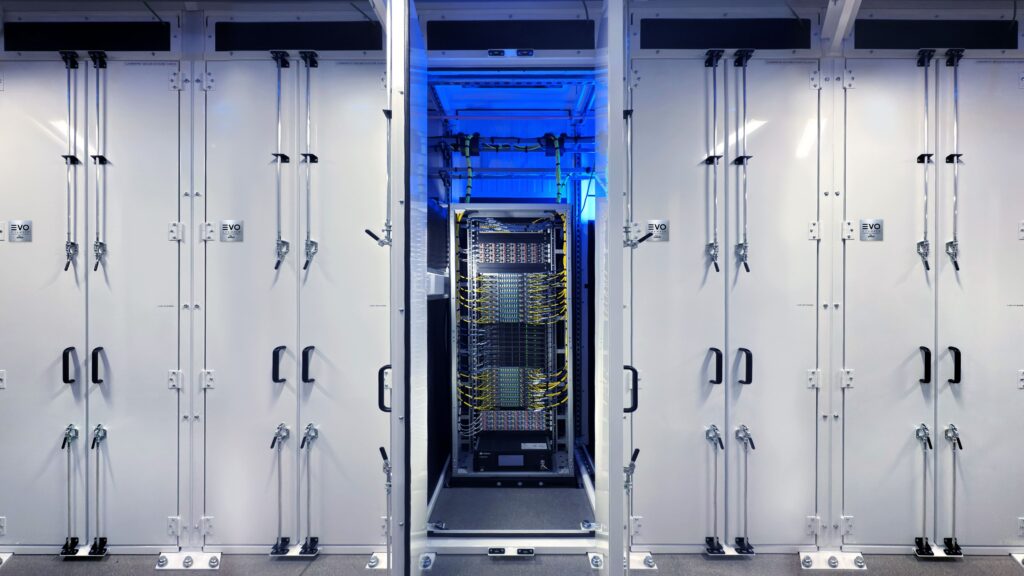Here’s the translation:
With over one exaflop of power per rack, NVIDIA’s new gem powered by Dell is now operational in the most ambitious AI cloud on the market.
In a sector where technological advancements are measured in months, not years, Dell Technologies and CoreWeave have just made astrong move. This week, both companies announced the deployment of the first production system NVIDIA GB300 NVL72: a high-performance computing rack designed to meet the new generation of artificial intelligence, characterized by massive inference, multimodal models, and the rise of agentic AI.
This is not just another launch. This system, which combines 72 NVIDIA Blackwell Ultra GPUs, 36 Arm architecture Grace CPUs, and an InfiniBand network of 800 Gb/s per GPU, is—literally—a liquid supercomputer packaged in a single rack. And this is no exaggeration: each can deliver over 1 exaflop of AI performance, a figure that until recently was reserved for the world’s major supercomputing centers.
What does this mean for AI?
The short answer: unprecedented speed, efficiency, and scale. According to data provided by CoreWeave and Dell, the GB300 NVL72 can improve response latency by up to 10 times for model reasoning tasks and achieves a 5x performance per watt compared to the previous Hopper architecture. All of this while managing up to 21 TB of HBM3e GPU memory per rack, ideal for language models with multiple trillion parameters.
It’s the kind of technical leap that not only excites engineers but also changes the game for those building the future. A case in point: Moonvalley, a young generative film startup, is already using this platform to develop real-time AI audiovisual creation tools.
“We’re building the future of cinema with AI. The arrival of the GB300 at CoreWeave allows us to think without limits,” explains Naeem Talukdar, CEO of Moonvalley.
An Ecosystem Tailored for the Future
But just as important as the hardware is the ecosystem that supports it. CoreWeave, which has positioned itself as the most specialized AI cloud on the market, has designed its infrastructure around these types of workloads. From its adapted Kubernetes (CKS) to proprietary tools like the Cabinet Wrangler and integration with Weights & Biases to correlate hardware failures with training sessions, everything is fine-tuned for precise, resilient, and optimized operation.
CoreWeave was also a pioneer in adopting the NVIDIA GB200, and its inference benchmarks more than doubled those of H100-based instances. Now, with the GB300, they aim to replicate—and surpass—that feat.
Dell Makes a Strong Bet on Enterprise AI
On Dell’s side, the delivery of these systems represents a consolidation of its strategy in specialized infrastructure. Arthur Lewis, president of Dell Technologies’ infrastructure solutions group, summarizes it bluntly: “We’re not just building servers. We’re defining how companies access the AI of tomorrow.”
Dell has been crucial not only for its ability to assemble and deploy these superracks but also for its network of services and support. The company offers professional AI services, data center design assistance, and a vertical integration covering computing, networking, and storage under a single architecture. The combination of Dell’s strength with CoreWeave’s cloud-native agility seems unbeatable for now.
And Now What?
What is a technological breakthrough today could soon be the foundation of a new digital infrastructure. As generative AI and agentic AI become key components of the economy, the kinds of systems that were once limited to elite laboratories are now accessible to startups, researchers, and companies that need to scale limitlessly.
Dell and CoreWeave have not only deployed new hardware. They have taken the first step toward an infrastructure designed for a world where artificial intelligence is not an option, but a necessity.
And as often happens in technology, the clock has already started ticking. Who will take the next step?
Source: Artificial Intelligence News

